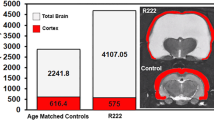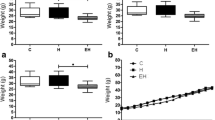Abstract
The learning ability of congenitally hydrocephalic HTX rats in which hydrocephalus had been arrested by the insertion of a V-P shunt 7 days after birth (early shunt) was assessed by means of the light-darkness discrimination test when the animals reached maturity. Early shunt placement resulted in marked reduction in size of abnormally enlarged ventricles and the prevention of both decreasing spine density and decay of synaptic vesicle protein (SVP-38) in the affected cerebral cortex. The learning ability of such animals was also found not to be impaired compared with that of animals in a sham-operation group. On the basis of these investigations, it is concluded that early shunt placement may have a beneficial role in preventing not only impairment of synaptogenesis of the brain by progressing hydrocephalus, but also learning disability. Recent biochemical investigation of the developing brains of hydrocephalic HTX rats revealed problems that cannot be resolved by early shunt insertion, and these are also discussed.
Similar content being viewed by others
References
Agranoff BW, Frey KA (1984) A regional metabolic contrast method for the study of brain pathology. Ann Neurol 15:93–97
Chugani HT, Phelps ME, Mazziotta JC (1987) Positron emission tomography: study of human brain functional development. Ann Neurol 22:487–497
Jones HC, Bucknall RM (1987) Changes in cerebrospinal fluid pressure and outflow from the lateral ventricles during development of congenital hydrocephalus in the HTX rat. Exp Neurol 98:573–583
Jones HC, Bucknall RM (1988) Inherited prenatal hydrocephalus in the HTX rat: a morphological study. Neuropathol Appl Neurobiol 14:263–274
Kohn DF, Chinookoswong N, Chou SM (1981) A new model of congenital hydrocephalus in the rat. Acta Neuropathol (Berl) 54:211–218
Kohn DF, Chinookoswong N, Chou SM (1984) Animal model of human disease. Congenital hydrocephalus. Am J Pathol 114:184–185
Laemmli UK (1970) Cleavage of structural proteins during the assembly of the head of bacteriophage T4. Nature 227:680–685
Millhouse OE (1981) The Golgi methods. In: Heimer L, RoBards MJ (eds) Neuroanatomical tract-tracing methods. Plenum Press, New York, pp 311–344
Miyaoka M, Ito M, Sato K, Ishii S (1988) Measurement of local cerebral glucose utilization before and after V-P shunt in congenital hydrocephalus in rats. Metab Brain Dis 3:125–132
Miyazawa T, Sato K (1991) Learning disability and impairment of synaptogenesis in HTX-rats with arrested shunt-dependent hydrocephalus. Child's Nerv Syst 7:121–128
Miyazawa T, Wada M, Sato K (1988) A quantitative Golgi study of cortical pyramidal neurons in congenitally hydrocephalic rats-HTX-Golgi study. Nerv Syst Child 13:263–270
Miyazawa T, Nishye H, Sato K, Kobayashi R, Hattori S, Shirai T, Obata K (1992) Cortical synaptogenesis in congenitally hydrocephalic HTX-rats with monoclonal antisynaptic vesicle protein antibody. Brain Dev 14:75–79
Obata K, Nishiye H, Fujita SC, Shirao T, Uchizono K (1986) Identification of a synaptic vesicle-specific 38,000-dalton protein by monoclonal antibodies. Brain Res 375:37–48
Suda K, Sato K, Takeda N, Wada M, Miyazawa T, Arai H, Ito M, Miyaoka M (1991) Early vs delayed ventriculoperitoneal shunt — effects on the impairment of the developing brain in congenitally hydrocephalic HTX-rats. In: Matsumoto S, Tamaki N (eds) Hydrocephalus — pathogenesis and treatment. Springer, Tokyo, pp 10–26
Takasima S, Chan F, Becker LE, Armstrong DL (1978) Morphology of the developing visual cortex of the human infant: a quantitative and qualitative Golgi study. J Neuropathol Exp Neurol 39:487–501
Wada M (1988) Congenital hydrocephalus in HTX rats: incidence, pathophysiology and developmental impairment. Neurol Med Chir (Tokyo) 28:955–964
Author information
Authors and Affiliations
Rights and permissions
About this article
Cite this article
Suda, K., Sato, K., Takeda, N. et al. Early ventriculoperitoneal shunt — effects on learning ability and synaptogenesis of the brain in congenitally hydrocephalic HTX rats. Child's Nerv Syst 10, 19–23 (1994). https://doi.org/10.1007/BF00313580
Issue Date:
DOI: https://doi.org/10.1007/BF00313580




